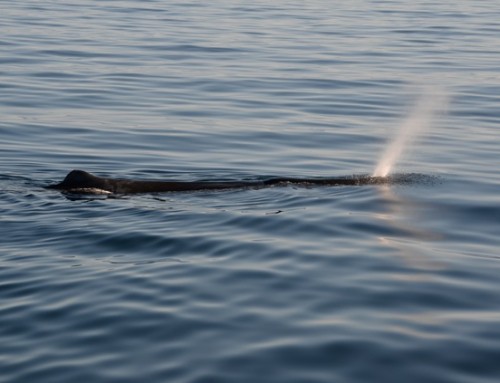The northern elephant seal (Mirounga angustirostris) is one of four species of pinnipeds regularly found in the waters around Baja California (for a discussion of pinnipeds in general, please see my Rob-servations Blog #10). There are two species of elephant seal in the world, the northern and southern, with the southern one being found in the southern hemisphere. The northern elephant seal is mostly found in the eastern North Pacific Ocean and is the species we see in Baja.
Elephant seals are members of the pinniped family Phocidae, as is the harbor seal, another Baja pinniped species.
All members of this family share various traits that help distinguish them from the other major group of pinnipeds, the family Otariidae (which includes the California sea lion and Guadalupe fur seal, both species found in Baja).
Elephant seals (and other phocids) lack an external ear flap, have relatively small front flippers (compared to otariids), cannot rotate their hind flippers forward, hunch along awkwardly when on land, and primarily use their hind flippers and bodies when swimming underwater (see Blog #10 for more details).
As a general rule, phocids tend to have little to no sexual dimorphism, while otariids are characterized by having sexual dimorphism. The term “sexual dimorphism” refers to the differences between male and female members of a species. Many people equate the term with differences in body size, but the term also encompasses other differences, such as the bright colors in some male birds, or the antlers in male deer. The BIG exception to the lack of sexual dimorphism in phocids is … the elephant seal! Male elephant seals are gigantic, much larger than the females. Elephant seals are not only the largest pinnipeds, but are also the most sexually dimorphic mammals. Adult male northern elephant seals get up to 4.2 meters (14 feet) and 2,500 kilograms (5,500 pounds), compared with 2.8 m (9 feet) and 600 kg (1,300 pounds) for females. Southern elephant seals get even larger!
Oftentimes a size disparity between male and female mammals suggests a polygynous mating system, in which a few males mate with many females. Elephant seals have such a mating system, where large bulls compete with each other for control of desirable sections of beach.
The best beaches have good haul-out sites for females to come ashore, give birth to their pups, nurse them for one month, and then mate again before heading back out to sea. The beachmaster bulls have mating access to many females (and get to pass on their genes to many pups), whereas the vanquished males may not get to mate at all that season.
Northern elephant seals haul out twice a year in certain select locations along the California and Baja California coasts. During our Searcher Natural History Tour to Baja, we spend a day on West San Benito Island, one of the three San Benito Islands that serve as the primary haul-out site for elephant seals in Baja. In addition to hauling out for pupping and mating, elephant seals haul out later in the year for molting, a process by which they shed old hair and skin quite rapidly (all mammals continuously shed old hair and skin, but elephant seals go through a “catastrophic molt”).
We always see elephant seals on West San Benito Island. However, the composition of the elephant seal groups varies by month. During the Searcher’s first trips of the year (late January and early February), we can see adult males and females, as well as very young pups. As the season progresses, we see fewer adult males and the pups are getting larger. By the time we get to April, few adult males are left, many of the pups have been weaned and their mothers have departed, and other elephant seals (mostly sub-adults) have arrived for molting.

Rob Nawojchik, author of Rob-servations, guides Searcher passengers around the elephant seal haul-out areas on scenic Isla San Benito.
When elephant seals leave the San Benito Islands, they head to their feeding grounds thousands of miles away in certain areas of the North Pacific Ocean. While there, they dive very deep to feed on squid. Elephant seals are the champion divers among pinnipeds, capable of diving deeper and longer than other species. In fact, the diving capabilities of elephant seals are comparable to that of sperm whales. Much of what we know about the movements and diving patterns of elephant seals comes from the use of satellite-linked time-depth recorders (TDRs) that are attached to the seals at their haul-out sites. Due to their double migration (one for reproduction and one for molting), northern elephant seals end up migrating more than any other mammal, up to 21,000 km (13,000 miles) per year!
While observing these amazing animals during our Baja tours, I like to remind everyone that elephant seals were hunted to the brink of extinction. It is only because of their current protected status, and safe havens such as the San Benito Islands, that the northern elephant seal has made such a remarkable recovery.









